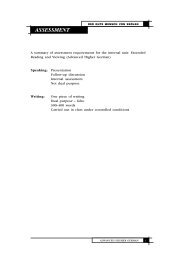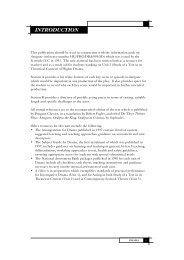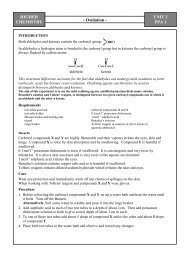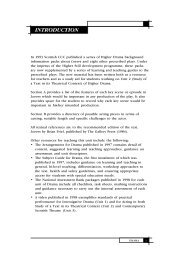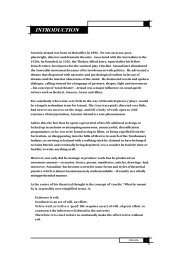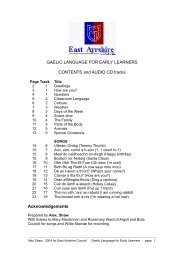PDF file: Higher Chemistry: Making Esters - Education Scotland
PDF file: Higher Chemistry: Making Esters - Education Scotland
PDF file: Higher Chemistry: Making Esters - Education Scotland
You also want an ePaper? Increase the reach of your titles
YUMPU automatically turns print PDFs into web optimized ePapers that Google loves.
HIGHER<br />
CHEMISTRY<br />
INTRODUCTION<br />
- <strong>Making</strong> <strong>Esters</strong>-<br />
One way of preparing esters is to condense an alcohol with a carboxylic acid:<br />
O<br />
O<br />
C R'<br />
R O H + H O<br />
R O<br />
C R'<br />
+ H 2 O<br />
UNIT 2<br />
PPA 2<br />
alcohol carboxylic acid ester<br />
The reaction is slow at room temperature and the yield of ester is low. The rate can be increased by heating the<br />
reaction mixture and by using concentrated sulphuric acid as a catalyst. The presence of the concentrated sulphuric<br />
acid also increases the yield of ester.<br />
The aim of this experiment is to prepare an ester and to identify some of the characteristic properties of esters.<br />
Requirements<br />
test tube and rack samples of alcohols (methanol, ethanol, propan-1-ol,<br />
test tube holder butan-1-ol and pentan-1-ol)<br />
paper towel samples of carboxylic acids (methanoic acid, ethanoic<br />
rubber band acid, propanoic acid, benzoic acid and salicylic acid)<br />
large beaker concentrated sulphuric acid<br />
small beaker 1 mol l -1 sodium hydrogencarbonate<br />
tripod<br />
Bunsen burner and heating mat<br />
cotton wool<br />
Hazards<br />
Concentrated sulphuric acid causes severe burns to the eyes and skin.<br />
Methanol, ethanol and propan-1-ol are highly flammable and butan-1-ol and pentan-1-ol are<br />
flammable.<br />
All the alcohols are harmful by inhalation, skin absorption and by swallowing. Methanol is toxic.<br />
The eyes may be damaged by alcohol splashes.<br />
Methanoic, ethanoic and propanoic acids are corrosive and the benzoic and salicylic acids are<br />
irritating to the eyes and skin.<br />
Care<br />
Wear goggles and immediately wash off any chemical spillages on the skin.<br />
Wear gloves when working with the concentrated sulphuric acid.<br />
When smelling the ester product do it very cautiously using the technique described below.<br />
Procedure<br />
Decide which ester you are to make and follow the procedure outlined below.<br />
1. Before collecting the alcohol and carboxylic acid set up a water bath using the larger beaker and<br />
heat the water until it boils. Turn off the Bunsen.<br />
Alternatively, boil some water in a kettle and pour it into the large beaker.<br />
2. Add the alcohol to a test tube to a depth of about 1 cm. To this add about the same volume of<br />
carboxylic acid. If the acid is a solid then use a spatulaful.<br />
3. In the interests of safety your teacher/lecturer may carry out the next step.<br />
Add about 5 drops of concentrated sulphuric acid to the reaction mixture.
HIGHER<br />
CHEMISTRY<br />
- <strong>Making</strong> <strong>Esters</strong>-<br />
UNIT 2<br />
PPA 2<br />
4. Soak the paper towel in cold water, fold it up and wrap it round the neck of the test tube.<br />
Secure it with a rubber band. This arrangement acts as a condenser when the reaction mixture<br />
is being heated.<br />
5. Place a loose plug of cotton wool in the mouth of the test tube. This will contain any<br />
chemicals which may spurt out of the reaction mixture when it is heated.<br />
6. Place the test tube in the hot water bath.<br />
7. While the reaction mixture is being heated add about 20 cm 3 of sodium hydrogencarbonate<br />
solution to the small beaker.<br />
8. After about 10 minutes, take the test tube from the water bath and remove the plug of cotton<br />
wool. Slowly pour the reaction mixture into the sodium hydrogencarbonate solution. This<br />
neutralises the sulphuric acid and any remaining carboxylic acid and so removes the smell of<br />
the carboxylic acid.<br />
9. Gently swirl the contents of the beaker and look to see if there is any sign of the ester<br />
separating from the aqueous mixture.<br />
10. To smell the ester follow the technique outlined below.<br />
First breathe in deeply to fill the lungs with uncontaminated air.<br />
With your nose at least 30 cm from the mouth of the beaker gently waft the vapour towards<br />
your nose and take just a sniff.
HIGHER<br />
CHEMISTRY<br />
Name:<br />
Date:<br />
- <strong>Making</strong> <strong>Esters</strong>-<br />
- ASSESSMENT SHEET -<br />
* State the aim of the experiment naming the ester you made.<br />
PC(b)<br />
Procedure<br />
* Draw a labelled diagram of the assembled apparatus used to prepare an ester.<br />
PC(b)<br />
* How was the reaction rate increased?<br />
PC(b)<br />
PC(a) PC(b) PC(c) PC(d) PC(e)<br />
* What was the function of the 'wet paper towel' condenser?<br />
PC(b)<br />
Results<br />
* State two pieces of evidence which suggested that an ester had been formed.<br />
PC(c)<br />
Teacher’s/Lecturer’s<br />
Initials<br />
UNIT 2<br />
PPA 2
HIGHER<br />
CHEMISTRY<br />
- <strong>Making</strong> <strong>Esters</strong>-<br />
Conclusion<br />
* Using full structural formulae, write an equation for the condensation reaction you<br />
carried out and name the ester formed.<br />
PC(e)<br />
UNIT 2<br />
PPA 2
HIGHER<br />
CHEMISTRY<br />
- <strong>Making</strong> <strong>Esters</strong>-<br />
- TEACHER/LECTURER/TECHNICIAN SHEET -<br />
Requirements per student (or group)<br />
Reagents<br />
selection of alcohols (~ 1 cm 3 )<br />
(methanol, ethanol, propan-1-ol, butan-1-ol<br />
and pentan-1-ol)<br />
selection of carboxylic acids (~ 1 cm 3 or 1 spatulaful)<br />
(methanoic acid, ethanoic acid, propanoic acid,<br />
benzoic acid and salicylic acid)<br />
CONCENTRATED SULPHURIC ACID (A FEW<br />
DROPS)<br />
1.0 mol l -1 sodium hydrogencarbonate (~ 20 cm 3 )<br />
(84.0 g sodium hydrogencarbonate per litre)<br />
methanol<br />
ethanol<br />
propan-1-ol<br />
butan-1-ol<br />
pentan-1-ol<br />
ethanoic acid<br />
methanoic<br />
acid<br />
propanoic<br />
acid<br />
benzoic acid<br />
salicylic acid<br />
toxic<br />
UNIT 2<br />
PPA 2<br />
highly<br />
flammable<br />
highly<br />
flammable<br />
harmful flammable<br />
corrosi<br />
ve<br />
concentrated sulphuric<br />
acid<br />
APPARATUS<br />
test tube (1) 100 cm 3 glass beaker (1)<br />
test tube rack (1) tripod (1)<br />
test tube holder (1)<br />
Bunsen burner (1)<br />
paper towel (1)<br />
heating mat (1)<br />
rubber band (1)<br />
400 cm<br />
cotton wool<br />
3 glass beaker (1)<br />
flammable<br />
corrosive<br />
harmful<br />
corrosive
HIGHER<br />
CHEMISTRY<br />
Safety Measures<br />
- <strong>Making</strong> <strong>Esters</strong>-<br />
Preparation/provision of: Main Hazards Control Measures<br />
methanol<br />
ethanol<br />
propan-1-ol<br />
butan-1-ol<br />
pentan-1-ol<br />
methanoic acid<br />
ethanoic acid<br />
propanoic acid<br />
benzoic acid<br />
salicylic acid<br />
All harmful to varying extent by<br />
ingestion, inhalation and by skin<br />
absorption.<br />
Methanol is more toxic than the<br />
others.<br />
Methanol, ethanol and propan-1-ol<br />
are highly flammable and the others<br />
are flammable.<br />
The three aliphatic acids are<br />
corrosive.<br />
Methanoic acid is quite toxic and<br />
ethanoic acid is flammable.<br />
The two aromatic acids are very<br />
irritating to the skin.<br />
concentrated sulphuric acid Causes severe burns to eyes and<br />
skin.<br />
Notes<br />
This experiment should be carried out in a well-ventilated room.<br />
UNIT 2<br />
PPA 2<br />
Wear eye protection and pvc gloves.<br />
Ensure absence of ignition sources.<br />
Dispense into small reagent bottles<br />
(say 50 or 100 cm 3 ) in a wellventilated<br />
room or preferably in a<br />
fume cupboard.<br />
Wear goggles and pvc gloves during<br />
dispensing.<br />
Ensure absence of ignition sources.<br />
Wear goggles or faceshield and pvc<br />
gloves.




